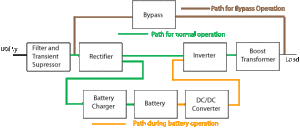There are several types of UPS systems each with their own unique advantages. Today we will describe two of the most common.
The most small UPS systems, 150 to 3000VA are Line Interactive design. Larger systems will use an Online design but in many cases both are available. So which should you have?
Line Interactive Design:
This topology is relatively simple. The power from the utility powers the load as long as it is within certain voltage and frequency limits. In older UPS systems, if the utility goes outside of this range, then the inverter turns on supplying power to the load and discharging the batteries. In current designs, internal circuitry will correct for minor variations in the voltage from the utility without going to battery. This preserves the batteries for a true power failure. Since the Inverter only turns on when there is a power failure, there is a switch over time of about 2 to 6 mseconds. Most modern computers can easily handle this delay. Below is a typical block diagram.
Advantages
– Low cost
– Some voltage regulation without going to battery
– Surge protection
– Pure sine wave output in the more expensive models
– Most efficient, 98%
Disadvantages
– Limited input voltage range before going to battery
– Step function when changing output voltage via steps in a transformer
– No overload capability
– Transfer time to go to battery, 2 to 6 ms
Online UPS Systems
Although slightly more expensive, the added protection may be worth it. Online systems run their inverter at all times from the input utility or the batteries, providing regulated power to the load. Since the inverter is always powering the load, the voltage and frequency can be carefully controlled and are not affected by fluctuations in the utility. In addition, if the load demands more power than available from the UPS, the system will transfer to bypass allowing the load to be powered directly from the utility. The unit will also go into bypass if there is a failure of the UPS circuitry ensuring the load will not be dropped if overloaded or even if the unit malfunctions. Below is the block diagram.
Advantages
– More stable power to your loads
– Overload protection
– Inverter failure protection
– Pure sinewave output (just like the utility)
– Perfect for use with generators (which tend to be less stable)
Disadvantages
– Slightly more expensive
– Less efficient since the inverter is always running, 88 to 92%
So which topography is right for you application?
It depends on the critical nature of your data. If you are powering a single desk top computer then a Line Interactive will do the job well and save you money. On the other hand if you are powering a few critical servers or a data center, then the extra cost of an Online UPS is well worth the extra expense!
For a more thorough discussion of the different types of UPS systems click here:
“Different Types of UPS Systems”
For a video graphically showing the differences click here:
| Call for a FREE survey of your application and recommendations for your load. The experts at UPSProtection/Automated Power can help you select the best performance and value for your specific needs. click here or call 800.755.0080. |
| UPS Protection also designs, sells and services Data Center Infrastructure products from APC, Liebert, Eaton, Generac and other major brands. |


